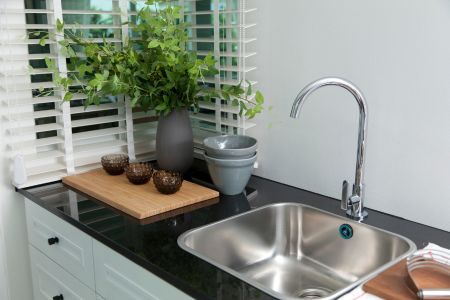Table of Contents
- Sink and Drain Refresh: Clean and Clog-Free
- What You’ll Need
- How to Clean a Stainless-Steel Kitchen Sink
- How to Clean a White Kitchen Sink
- How to Clean a Porcelain Kitchen Sink
- How to Clean Kitchen Faucets and Handles
- Ways to Clean a Drain
- How to Clean a Drain with Baking Soda and Vinegar
- Key Takeaways
- Conclusion
Sink and Drain Refresh: Clean and Clog-Free
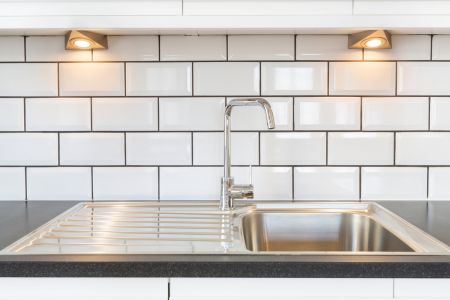
Ah, the kitchen – the heart of our homes where delicious meals come to life! But here’s a fact: a clean kitchen doesn’t just mean sparkling countertops or shiny appliances.
One of the often overlooked heroes in maintaining a spotless kitchen is the sink, and let’s remember the drain that swallows up all our leftovers and much more.
While our sinks bravely take on grease, food scraps, and many stains daily, our drains battle against clogs, gunk, and those not-so-pleasant odors. It’s high time we show them love and attention.
Maintaining a gleaming sink and a clear-flowing drain is easier than it sounds, especially when armed with the proper knowledge.
Think about it: having a clean sink and drain can make your kitchen tasks more pleasant and even keep unwanted visitors (hello, tiny fruit flies) away.
Plus, when your sink shines and your drain flows freely, you get that unique sense of accomplishment, knowing that every corner of your kitchen is tip-top.
So, whether you’re tired of looking at those stubborn sink stains or you’ve had enough of that slow-draining water, you’re in the right place!
Get ready to dive deep into expert-approved ways to care for and clean your kitchen’s dynamic duo – the sink and drain. Trust us; your kitchen will thank you!
What You’ll Need
Equipment / Tools
- Scrubbing brush: A local “walis” (broom) with stiffer bristles for this task can be repurposed
- Soft cloth or rag: “Basahan,” typically used for wiping surfaces in Filipino households.
- Old toothbrush: Perfect for those hard-to-reach areas and detailed cleaning.
Materials for Cleaning a Stainless-Steel Kitchen Sink
- Dishwashing liquid: Brands like Joy or Axion are popular in the Philippines.
- White vinegar: Datu Puti or Silver Swan are commonly available.
Materials for Cleaning a White Kitchen Sink
- Dishwashing liquid (as mentioned above).
- Baking soda: Local grocery stores often carry this in their baking section.
Materials for Cleaning a Porcelain Kitchen Sink
- Dishwashing liquid.
- Cream of tartar: This baking section in local supermarkets can be used
Materials for Cleaning a Kitchen Drain with Baking Soda and Vinegar
- Baking soda.
- White vinegar (as mentioned above).
Materials for Cleaning a Garbage Disposal
- Ice cubes: Made from clean water.
- Rock or coarse salt: Local brands like Fita or Tawas can be used.
- Lemon: Local markets or supermarkets have this; you can choose from native or imported varieties.
Remember, it’s always a good idea to source and use local products whenever possible. They’re easily available, affordable, and work as effectively as any international brand. Plus, supporting local helps our economy!
How to Clean a Stainless-Steel Kitchen Sink
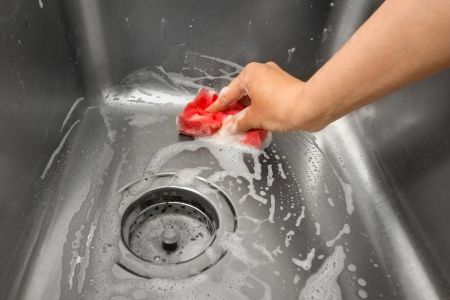
Stainless steel sinks are pretty beautiful, right? They’re modern, sleek, and shine like a new coin when they’re clean. But with daily use, they might get a bit dull with spots and streaks. Fear not, dear reader! Cleaning them is easier than preparing our favorite adobo.
Here’s a simple guide tailored for our fellow Filipinos:
- Rinse First: Start by splashing your sink with plain water. This initial rinse will wash away the top layer of any leftover food or liquids.
- Soap It Up: Add a few drops of a local dishwashing liquid, perhaps Joy or Axion, to a soft “Bashan” (cloth). Gently scrub the sink in the direction of its grain. Fun fact: Like wood, stainless steel has a grain pattern!
- Tackle Stubborn Spots: Grab some white vinegar if you notice any hard-to-remove spots or watermarks. Brands like Datu Puti or Silver Swan are perfect. Dab some vinegar onto another cloth and gently wipe those pesky spots away. And, of course, give a quick rinse afterward to keep things fresh.
- Buff and Shine: To wrap things up and get that brand-new gleam, dry off the sink and then buff it using a dry cloth. This extra step makes a difference, giving it a shine reminiscent of our beautiful sunrises.
So, there you have it! A spotless sink in just four steps. With this guide, your sink won’t just be clean; it’ll be the star of your kitchen.
How to Clean a White Kitchen Sink
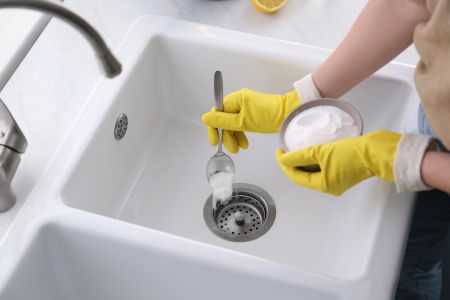
White kitchen sinks, with their pristine appearance, bring a touch of elegance to our kitchens. But just like our favorite white shirts, they can easily show stains and dirt.
Here’s a Filipino guide to keeping that white sink sparkling:
- Gentle Initial Rinse: Begin by splashing your sink with lukewarm water. This will help dislodge any immediate debris or stains. Remember, we’re going gentle – no need to make it a mini Baguio downpour!
- Lather It Up: Using our trusty local dishwashing liquid (Joy or Axion, anyone?), create a bubbly lather on a soft rag Work this soapy cloth around the sink, focusing mainly on any noticeable spots.
- Baking Soda Magic: For those stubborn marks that seem to have made your sink their permanent residence, baking soda will be your best friend. Sprinkle some over the stains and gently scrub it with a soft brush. Just like rice is the base for many of our meals, consider baking soda the foundation for challenging cleaning tasks.
- Vinegar Finishing Touch: Here’s a trick if some stains remain uninvited. Mix equal parts white vinegar (Datu Puti or Silver Swan works excellently) with water in a bowl. Soak a cloth in this solution and gently dab over the stubborn stains. This combination acts like a natural bleaching agent without the harsh chemicals.
- Rinse and Shine: Thoroughly rinse off any remaining product to reveal the shining glory of your white sink. Finish by wiping it down with a dry cloth, ensuring it remains spotless and gleaming.
There you go! With this method, your white kitchen sink will rival the brightness of our most beautiful white sand beaches.
Enjoy the view every time you walk into your kitchen!
How to Clean a Porcelain Kitchen Sink
Ah, the classic porcelain kitchen sink. With its smooth finish and timeless charm, it’s no wonder many Filipinos opt for this beauty in their homes.
But just like our pristine beaches, it needs a little TLC to keep its allure. Ready to get started?
Let’s dive into the Filipino way of keeping our porcelain sinks spotless.
- Lukewarm Prelude: Gently rinse your sink with lukewarm water. This simple step prepares the surface by washing away any immediate debris.
- Suds and Scrub: Grab our homegrown dishwashing liquid – our ever-reliable Joy or Axion – and add a few drops to a water basin. Dip a soft sponge or “basahan” into the soapy solution and scrub your sink in a circular motion. Gentle strokes, kaibigan! We want to avoid scratching our lovely sink.
- Baking Soda for the Stubborn Ones: Encountered a stubborn stain claiming squatter’s rights? Fear not. Sprinkle baking soda over the troublemaker and gently scrub with a soft brush. Baking soda acts as a gentle abrasive, like our island’s peaceful sands brushing against our feet.
- White Vinegar to the Rescue: If you spot any lingering stains, a mix of equal parts white vinegar (like our favorite Datu Puti) and water will do wonders. Dip a cloth into this mix and rub over the stains in a gentle circular motion.
- Final Flushing: Now, for the grand finale! Rinse the sink with cool water, washing away any remnants of your cleaning concoction. Give it a good wipe with a dry cloth for that extra sparkle.
How to Clean Kitchen Faucets and Handles
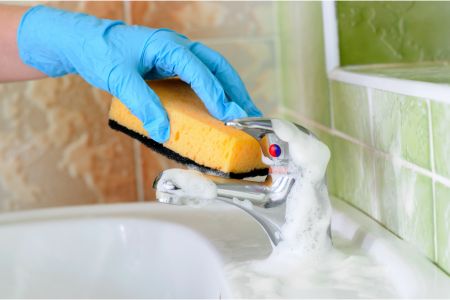
Like Manila’s bustling streets, people constantly touch and use kitchen faucets and handles, accumulating grime rapidly. But don’t worry! Using local knowledge and common household products, you can make your faucets shine as brightly as the city lights in the night sky.
Here’s the Filipino guide to achieving that gleam:
- Start with a Splash: Just as rain refreshes our hot streets, then splash your faucet and handles with lukewarm water. This step loosens up the surface dirt.
- Soapy Solution: It’s time to bring out our trusty local dishwashing liquid (looking at you, Joy and Axion). Mix a few drops in a water bowl to create a soapy paradise. Using a soft cloth or “basahan,” gently scrub the faucet and handles. This step will remove the initial layer of dirt and grime, making our taps look like they’ve had a mini vacation.
- Baking Soda’s Time to Shine: Notice any hard water stains or more stubborn grime? Sprinkle baking soda on these spots and use an old toothbrush to scrub away gently. The texture of baking soda acts as a light abrasive, ensuring that stubborn areas vanish without scratching the fixtures.
- Vinegar for Victory: Hard water stains can be quite persistent, much like our love for karaoke. If some remain, dip a cloth in a mix of equal parts white vinegar (yes, our pantry-staple Datu Puti) and water. Wrap the fabric around the stain for a few minutes, then gently rub away. This will help dissolve those stubborn marks, making our faucets sing joyfully!
- The Final Touch: Rinse with water, ensuring no residue remains. To add a finishing shine, buff your faucets and handles with a dry cloth, capturing the shimmer of city lights in your kitchen.
There you have it!
Keep up the great work, and let your kitchen’s beauty shine!
Ways to Clean a Drain
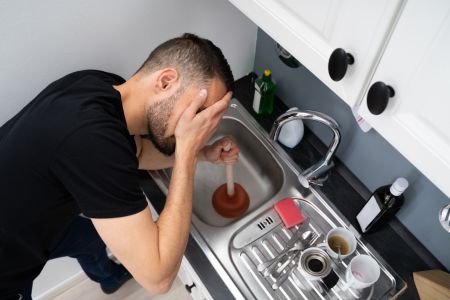
We’ve all been there: the water starts pooling in the sink, taking its sweet time to go down the drain.
A clogged drain can turn a good day into a stressful one, but fear not! Whether you’re dealing with a kitchen sink after a hearty adobo meal or a bathroom drain filled with hair, there are simple ways to tackle that pesky blockage.
Let’s explore efficient methods to keep our drains clean, clear, and flowing smoothly. Ready?
How to Clean a Drain with Baking Soda and Vinegar
Have you ever heard of the magic duo, baking soda and vinegar? These two kitchen staples aren’t just for cooking your favorite Filipino dishes; they’re the superhero team-up for drain cleaning, too! Combined, they create a fizzy reaction, perfect for busting those drain clogs.
Here’s a simple guide:
- Prepare the Magic Mix: Start by scooping about a cup of baking soda and pouring it directly into the drain. It acts as the scouring agent, ready to tackle the gunk.
- Enter the Vinegar: Slowly pour a cup of white vinegar into the drain. As it meets the baking soda, you’ll witness their bubbly dance. This fizz is actively breaking down the grimy stuff clogging your drain.
- Let Them Work: Allow this dynamic duo to sit and work their magic for about 30 minutes. They’re like the unseen “duwendes” working tirelessly to clear the path.
- Flush and Finish: Flush the drain with hot water after the waiting game. As the water flows, it removes the loosened debris, leaving you with a clean and clear drain.
Voilà! A hassle-free, natural method to keep your drains flowing like the Pasig River in its prime!
Key Takeaways
- Natural Cleaners: Household items like baking soda and vinegar can effectively clear your drains, proving you don’t always need harsh chemicals.
- Type of Sink Matters: The material of your kitchen sink – be it stainless steel, white, or porcelain – dictates the cleaning method for the best results.
- Faucet Focus: Remember faucets and handles! They’re frequently touched and deserve a good clean.
- Regular Maintenance: Routine cleaning can prevent major clogs and keep your sinks and drains in tip-top shape.
Conclusion
The kitchen is often the heart of our homes, with the sink being its hardworking helper. It sees everything from the aftermath of our delicious Filipino feasts to the dirt and grime from our daily lives.
Ensuring it’s clean makes our kitchen more appealing and keeps everything running smoothly. By using simple, natural methods and understanding the unique needs of our sinks, we can ensure they serve us well for years to come.
Remember, a clean sink and a drain pipe are the way for more delightful cooking and fewer plumbing headaches!
Stay clean and happy draining!
